
Question Number 176387 by cortano1 last updated on 19/Sep/22
![x^3 +(1/x^3 ) = 1 ⇒(([x^5 +(1/x^5 )]^3 −1)/(x^5 +(1/x^5 ))) =?](Q176387.png)
$$\:\:\mathrm{x}^{\mathrm{3}} +\frac{\mathrm{1}}{\mathrm{x}^{\mathrm{3}} }\:=\:\mathrm{1}\:\Rightarrow\frac{\left[\mathrm{x}^{\mathrm{5}} +\frac{\mathrm{1}}{\mathrm{x}^{\mathrm{5}} }\right]^{\mathrm{3}} −\mathrm{1}}{\mathrm{x}^{\mathrm{5}} +\frac{\mathrm{1}}{\mathrm{x}^{\mathrm{5}} }}\:=? \\ $$
Commented by mr W last updated on 18/Sep/22
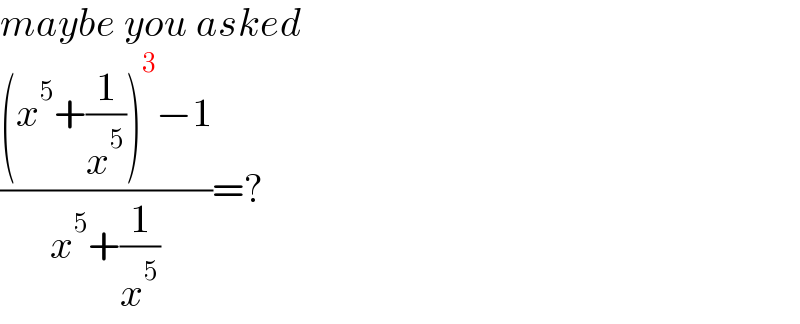
$${maybe}\:{you}\:{asked} \\ $$$$\frac{\left({x}^{\mathrm{5}} +\frac{\mathrm{1}}{{x}^{\mathrm{5}} }\right)^{\mathrm{3}} −\mathrm{1}}{{x}^{\mathrm{5}} +\frac{\mathrm{1}}{{x}^{\mathrm{5}} }}=? \\ $$
Commented by cortano1 last updated on 19/Sep/22

$$\mathrm{oo}\:\mathrm{yes}.\:\mathrm{typo} \\ $$
Commented by mr W last updated on 19/Sep/22
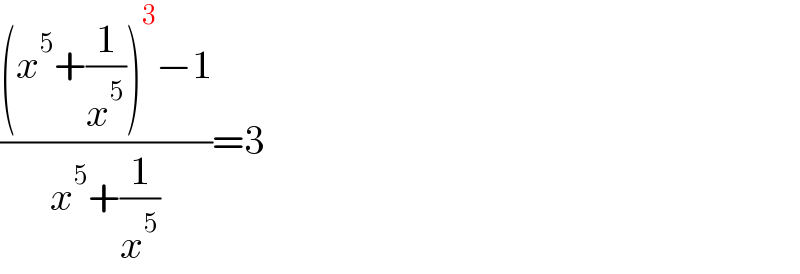
$$\frac{\left({x}^{\mathrm{5}} +\frac{\mathrm{1}}{{x}^{\mathrm{5}} }\right)^{\mathrm{3}} −\mathrm{1}}{{x}^{\mathrm{5}} +\frac{\mathrm{1}}{{x}^{\mathrm{5}} }}=\mathrm{3} \\ $$
Commented by cortano1 last updated on 19/Sep/22

$$\mathrm{nice} \\ $$
Commented by cortano1 last updated on 19/Sep/22

$$\:\:\mathrm{i}\:\mathrm{got}\:\mathrm{the}\:\mathrm{same}\:\mathrm{answer}\:\mathrm{by}\:\mathrm{complex} \\ $$$$\mathrm{numbers} \\ $$
Answered by BaliramKumar last updated on 18/Sep/22

$$\frac{\mathrm{2}{sin}\left(\mathrm{10}°\right)+\mathrm{1}}{\mathrm{2}{sin}\left(\mathrm{10}°\right)} \\ $$
Answered by Rasheed.Sindhi last updated on 19/Sep/22

$$ \\ $$$$\:\:\mathrm{x}^{\mathrm{3}} +\frac{\mathrm{1}}{\mathrm{x}^{\mathrm{3}} }\:=\:\mathrm{1}\:\Rightarrow\frac{\left(\mathrm{x}^{\mathrm{5}} +\frac{\mathrm{1}}{\mathrm{x}^{\mathrm{5}} }\right)^{\mathrm{3}} −\mathrm{1}}{\mathrm{x}^{\mathrm{5}} +\frac{\mathrm{1}}{\mathrm{x}^{\mathrm{5}} }}\:=? \\ $$$${x}^{\mathrm{3}} +\frac{\mathrm{1}}{{x}^{\mathrm{3}} }=\mathrm{1} \\ $$$${x}^{\mathrm{6}} −{x}^{\mathrm{3}} +\mathrm{1}=\mathrm{0} \\ $$$${x}^{\mathrm{3}} ={y}:\:\:{y}^{\mathrm{2}} −{y}+\mathrm{1}=\mathrm{0} \\ $$$$\Rightarrow\left({y}+\mathrm{1}\right)\left({y}^{\mathrm{2}} −{y}+\mathrm{1}\right)=\mathrm{0}\Rightarrow{y}^{\mathrm{3}} +\mathrm{1}=\mathrm{0} \\ $$$$\Rightarrow{y}=−\mathrm{1},−\omega,−\omega^{\mathrm{2}} \\ $$$${y}=−\mathrm{1}\:{is}\:{root}\:{of}\:{y}+\mathrm{1}=\mathrm{0} \\ $$$${y}=−\omega,−\omega^{\mathrm{2}} \:{are}\:{the}\:{roots}\:{of}\:{y}^{\mathrm{2}} −{y}+\mathrm{1}=\mathrm{0} \\ $$$$\therefore\:{x}^{\mathrm{3}} =−\omega,−\omega^{\mathrm{2}} \\ $$$$\:\:\:\:\:{x}=−\omega^{\mathrm{1}/\mathrm{3}} ,−\omega^{\mathrm{2}/\mathrm{3}} \\ $$$$\:\:\:\:{x}^{\mathrm{5}} =−\omega^{\mathrm{5}/\mathrm{3}} ,−\omega^{\mathrm{10}/\mathrm{3}} \\ $$$$\:\:\:\:{x}^{−\mathrm{5}} =−\omega^{−\mathrm{5}/\mathrm{3}} ,−\omega^{−\mathrm{10}/\mathrm{3}} \\ $$$${x}^{\mathrm{5}} +{x}^{−\mathrm{5}} =−\omega^{\mathrm{5}/\mathrm{3}} −\omega^{−\mathrm{5}/\mathrm{3}} ,\:\:\:−\omega^{\mathrm{10}/\mathrm{3}} −\omega^{−\mathrm{10}/\mathrm{3}} \\ $$$$\left({x}^{\mathrm{5}} +{x}^{−\mathrm{5}} \right)^{\mathrm{3}} =\left({x}^{\mathrm{5}} \right)^{\mathrm{3}} +\left({x}^{−\mathrm{5}} \right)^{\mathrm{3}} +\mathrm{3}\left({x}^{\mathrm{5}} +{x}^{−\mathrm{5}} \right) \\ $$$$\:\:\:\:\:\:\:\:\:\:\:\:\:\:\begin{cases}{=−\omega^{\mathrm{5}} −\omega^{−\mathrm{5}} +\mathrm{3}\left(−\omega^{\mathrm{5}/\mathrm{3}} −\omega^{−\mathrm{5}/\mathrm{3}} \right)\:}\\{=−\omega^{\mathrm{10}} −\omega^{−\mathrm{10}} +\mathrm{3}\left(−\omega^{\mathrm{10}/\mathrm{3}} −\omega^{−\mathrm{10}/\mathrm{3}} \right)}\end{cases}\:\: \\ $$$$\:\:\:\:\:\:\:\:\:\:\:\:\:\:\begin{cases}{=−\omega^{\mathrm{2}} −\omega+\mathrm{3}\left(−\omega^{\mathrm{5}/\mathrm{3}} −\omega^{−\mathrm{5}/\mathrm{3}} \right)\:}\\{=−\omega−\omega^{\mathrm{2}} +\mathrm{3}\left(−\omega^{\mathrm{10}/\mathrm{3}} −\omega^{−\mathrm{10}/\mathrm{3}} \right)}\end{cases}\:\: \\ $$$$\:\:\:\:\:\:\:\:\:\:\:\:\:\:\begin{cases}{=\mathrm{1}+\mathrm{3}\left(−\omega^{\mathrm{5}/\mathrm{3}} −\omega^{−\mathrm{5}/\mathrm{3}} \right)\:}\\{=\mathrm{1}+\mathrm{3}\left(−\omega^{\mathrm{10}/\mathrm{3}} −\omega^{−\mathrm{10}/\mathrm{3}} \right)}\end{cases}\:\: \\ $$$$\blacktriangleright\:\frac{\left({x}^{\mathrm{5}} +\frac{\mathrm{1}}{{x}^{\mathrm{5}} }\right)^{\mathrm{3}} −\mathrm{1}}{{x}^{\mathrm{5}} +\frac{\mathrm{1}}{{x}^{\mathrm{5}} }} \\ $$$$\:\:\:\:\:\:=\begin{cases}{\frac{\mathrm{1}+\mathrm{3}\left(−\omega^{\mathrm{5}/\mathrm{3}} −\omega^{−\mathrm{5}/\mathrm{3}} \right)−\mathrm{1}}{−\omega^{\mathrm{5}/\mathrm{3}} −\omega^{−\mathrm{5}/\mathrm{3}} }}\\{\frac{\mathrm{1}+\mathrm{3}\left(−\omega^{\mathrm{10}/\mathrm{3}} −\omega^{−\mathrm{10}/\mathrm{3}} \right)−\mathrm{1}}{−\omega^{\mathrm{10}/\mathrm{3}} −\omega^{−\mathrm{10}/\mathrm{3}} }}\end{cases}\: \\ $$$$\:\:\:\:\:\:=\begin{cases}{\frac{\mathrm{3}\left(\cancel{−\omega^{\mathrm{5}/\mathrm{3}} −\omega^{−\mathrm{5}/\mathrm{3}} }\right)}{\cancel{−\omega^{\mathrm{5}/\mathrm{3}} −\omega^{−\mathrm{5}/\mathrm{3}} }}=\mathrm{3}}\\{\frac{\mathrm{3}\left(\cancel{−\omega^{\mathrm{10}/\mathrm{3}} −\omega^{−\mathrm{10}/\mathrm{3}} }\right)}{\cancel{−\omega^{\mathrm{10}/\mathrm{3}} −\omega^{−\mathrm{10}/\mathrm{3}} }}=\mathrm{3}}\end{cases}\: \\ $$
Commented by mr W last updated on 19/Sep/22
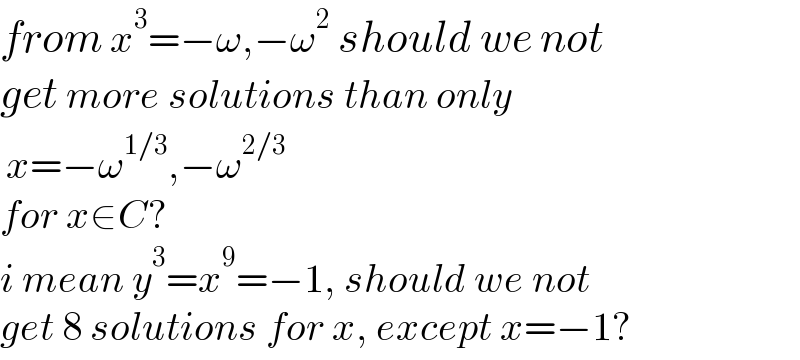
$${from}\:{x}^{\mathrm{3}} =−\omega,−\omega^{\mathrm{2}} \:{should}\:{we}\:{not} \\ $$$${get}\:{more}\:{solutions}\:{than}\:{only} \\ $$$$\:{x}=−\omega^{\mathrm{1}/\mathrm{3}} ,−\omega^{\mathrm{2}/\mathrm{3}} \\ $$$${for}\:{x}\in{C}? \\ $$$${i}\:{mean}\:{y}^{\mathrm{3}} ={x}^{\mathrm{9}} =−\mathrm{1},\:{should}\:{we}\:{not} \\ $$$${get}\:\mathrm{8}\:{solutions}\:{for}\:{x},\:{except}\:{x}=−\mathrm{1}? \\ $$
Commented by Rasheed.Sindhi last updated on 19/Sep/22
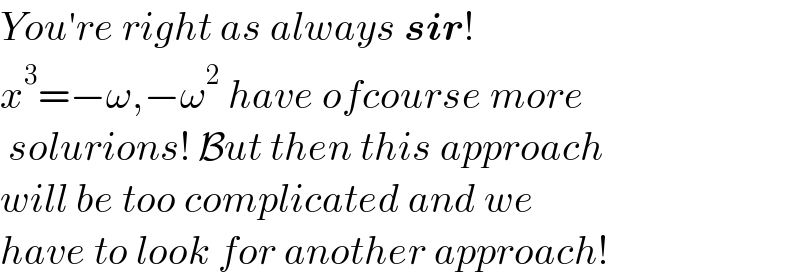
$${You}'{re}\:{right}\:{as}\:{always}\:\boldsymbol{{sir}}! \\ $$$${x}^{\mathrm{3}} =−\omega,−\omega^{\mathrm{2}} \:{have}\:{ofcourse}\:{more} \\ $$$$\:{solurions}!\:\mathcal{B}{ut}\:{then}\:{this}\:{approach} \\ $$$${will}\:{be}\:{too}\:{complicated}\:{and}\:{we} \\ $$$${have}\:{to}\:{look}\:{for}\:{another}\:{approach}! \\ $$
Commented by mr W last updated on 19/Sep/22
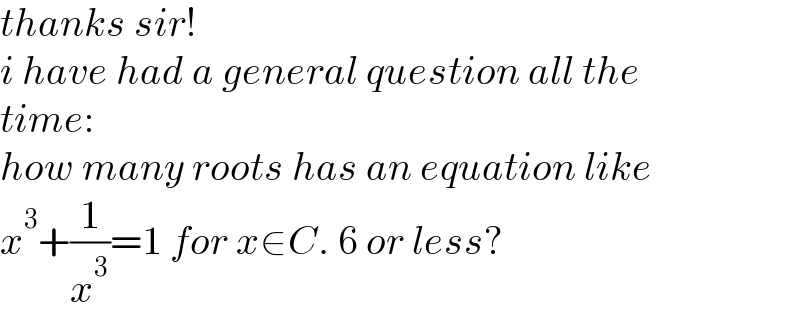
$${thanks}\:{sir}! \\ $$$${i}\:{have}\:{had}\:{a}\:{general}\:{question}\:{all}\:{the} \\ $$$${time}: \\ $$$${how}\:{many}\:{roots}\:{has}\:{an}\:{equation}\:{like} \\ $$$${x}^{\mathrm{3}} +\frac{\mathrm{1}}{{x}^{\mathrm{3}} }=\mathrm{1}\:{for}\:{x}\in{C}.\:\mathrm{6}\:{or}\:{less}? \\ $$
Commented by cortano1 last updated on 19/Sep/22

$$\mathrm{thanks}\:\mathrm{you} \\ $$
Answered by mr W last updated on 18/Sep/22
![x+(1/x)=a, say x^2 +(1/x^2 )=a^2 −2 (x^2 +(1/x^2 ))(x+(1/x))=(a^2 −2)a x^3 +(1/x^3 )+x+(1/x)=(a^2 −2)a 1+a=(a^2 −2)a a^3 −3a−1=0 ⇒a=2 sin (((2kπ)/3)−(π/(18))) (k=0,1,2) (x^3 +(1/x^3 ))(x^2 +(1/x^2 ))=1×(a^2 −2) x^5 +(1/x^5 )+x+(1/x)=1×(a^2 −2) x^5 +(1/x^5 )+a=a^2 −2 ⇒x^5 +(1/x^5 )=a^2 −a−2=(a+1)(a−2) ((x^5 +(1/x^5 )−1)/(x^5 +(1/x^5 )))=1−(1/((a+1)(a−2))) =1−(1/(4[sin (((2kπ)/3)−(π/(18)))+(1/2)][sin (((2kπ)/3)−(π/(18)))−1]))](Q176417.png)
$${x}+\frac{\mathrm{1}}{{x}}={a},\:{say} \\ $$$${x}^{\mathrm{2}} +\frac{\mathrm{1}}{{x}^{\mathrm{2}} }={a}^{\mathrm{2}} −\mathrm{2} \\ $$$$\left({x}^{\mathrm{2}} +\frac{\mathrm{1}}{{x}^{\mathrm{2}} }\right)\left({x}+\frac{\mathrm{1}}{{x}}\right)=\left({a}^{\mathrm{2}} −\mathrm{2}\right){a} \\ $$$${x}^{\mathrm{3}} +\frac{\mathrm{1}}{{x}^{\mathrm{3}} }+{x}+\frac{\mathrm{1}}{{x}}=\left({a}^{\mathrm{2}} −\mathrm{2}\right){a} \\ $$$$\mathrm{1}+{a}=\left({a}^{\mathrm{2}} −\mathrm{2}\right){a} \\ $$$${a}^{\mathrm{3}} −\mathrm{3}{a}−\mathrm{1}=\mathrm{0} \\ $$$$\Rightarrow{a}=\mathrm{2}\:\mathrm{sin}\:\left(\frac{\mathrm{2}{k}\pi}{\mathrm{3}}−\frac{\pi}{\mathrm{18}}\right)\:\left({k}=\mathrm{0},\mathrm{1},\mathrm{2}\right) \\ $$$$ \\ $$$$\left({x}^{\mathrm{3}} +\frac{\mathrm{1}}{{x}^{\mathrm{3}} }\right)\left({x}^{\mathrm{2}} +\frac{\mathrm{1}}{{x}^{\mathrm{2}} }\right)=\mathrm{1}×\left({a}^{\mathrm{2}} −\mathrm{2}\right) \\ $$$${x}^{\mathrm{5}} +\frac{\mathrm{1}}{{x}^{\mathrm{5}} }+{x}+\frac{\mathrm{1}}{{x}}=\mathrm{1}×\left({a}^{\mathrm{2}} −\mathrm{2}\right) \\ $$$${x}^{\mathrm{5}} +\frac{\mathrm{1}}{{x}^{\mathrm{5}} }+{a}={a}^{\mathrm{2}} −\mathrm{2} \\ $$$$\Rightarrow{x}^{\mathrm{5}} +\frac{\mathrm{1}}{{x}^{\mathrm{5}} }={a}^{\mathrm{2}} −{a}−\mathrm{2}=\left({a}+\mathrm{1}\right)\left({a}−\mathrm{2}\right) \\ $$$$\frac{{x}^{\mathrm{5}} +\frac{\mathrm{1}}{{x}^{\mathrm{5}} }−\mathrm{1}}{{x}^{\mathrm{5}} +\frac{\mathrm{1}}{{x}^{\mathrm{5}} }}=\mathrm{1}−\frac{\mathrm{1}}{\left({a}+\mathrm{1}\right)\left({a}−\mathrm{2}\right)} \\ $$$$=\mathrm{1}−\frac{\mathrm{1}}{\mathrm{4}\left[\mathrm{sin}\:\left(\frac{\mathrm{2}{k}\pi}{\mathrm{3}}−\frac{\pi}{\mathrm{18}}\right)+\frac{\mathrm{1}}{\mathrm{2}}\right]\left[\mathrm{sin}\:\left(\frac{\mathrm{2}{k}\pi}{\mathrm{3}}−\frac{\pi}{\mathrm{18}}\right)−\mathrm{1}\right]} \\ $$
Commented by Tawa11 last updated on 19/Sep/22

$$\mathrm{Great}\:\mathrm{sirs} \\ $$
Answered by Rasheed.Sindhi last updated on 19/Sep/22
![x^3 +(1/x^3 ) = 1 ⇒(([x^5 +(1/x^5 )]^3 −1)/(x^5 +(1/x^5 ))) =? x^6 −x^3 +1=0 x^6 =x^3 −1 { ((x^(12) =x^6 −2x^3 +1=x^3 −1−2x^3 +1=−x^3 )),((x^(−12) =(1/x^(12) )=(1/(−x^3 ))=−(1/x^3 ))) :} { ((x^(15) =x^(12) ∙x^3 =−x^3 ∙x^3 =−x^6 )),((x^(−15) =(1/x^(15) )=−(1/x^6 ))) :} .... x^(15) =x^(12) ∙x^3 =−x^6 =−(x^3 −1)=1−x^3 x^3 =1−x^(−3) x^5 =x^3 ∙x^2 =x^2 −x^(−1) x^(−3) =1−x^3 x^(−5) =x^(−3) ∙x^(−2) =x^(−2) −x x^5 +(1/x^5 )=x^2 −x^(−1) +x^(−2) −x =x^2 +(1/x^2 )−(x+(1/x)) Continue...](Q176445.png)
$$\:\:\mathrm{x}^{\mathrm{3}} +\frac{\mathrm{1}}{\mathrm{x}^{\mathrm{3}} }\:=\:\mathrm{1}\:\Rightarrow\frac{\left[\mathrm{x}^{\mathrm{5}} +\frac{\mathrm{1}}{\mathrm{x}^{\mathrm{5}} }\right]^{\mathrm{3}} −\mathrm{1}}{\mathrm{x}^{\mathrm{5}} +\frac{\mathrm{1}}{\mathrm{x}^{\mathrm{5}} }}\:=? \\ $$$${x}^{\mathrm{6}} −{x}^{\mathrm{3}} +\mathrm{1}=\mathrm{0} \\ $$$${x}^{\mathrm{6}} ={x}^{\mathrm{3}} −\mathrm{1} \\ $$$$\begin{cases}{{x}^{\mathrm{12}} ={x}^{\mathrm{6}} −\mathrm{2}{x}^{\mathrm{3}} +\mathrm{1}={x}^{\mathrm{3}} −\mathrm{1}−\mathrm{2}{x}^{\mathrm{3}} +\mathrm{1}=−{x}^{\mathrm{3}} }\\{{x}^{−\mathrm{12}} =\frac{\mathrm{1}}{{x}^{\mathrm{12}} }=\frac{\mathrm{1}}{−{x}^{\mathrm{3}} }=−\frac{\mathrm{1}}{{x}^{\mathrm{3}} }}\end{cases}\: \\ $$$$\begin{cases}{{x}^{\mathrm{15}} ={x}^{\mathrm{12}} \centerdot{x}^{\mathrm{3}} =−{x}^{\mathrm{3}} \centerdot{x}^{\mathrm{3}} =−{x}^{\mathrm{6}} }\\{{x}^{−\mathrm{15}} =\frac{\mathrm{1}}{{x}^{\mathrm{15}} }=−\frac{\mathrm{1}}{{x}^{\mathrm{6}} }}\end{cases}\: \\ $$$$.... \\ $$$${x}^{\mathrm{15}} ={x}^{\mathrm{12}} \centerdot{x}^{\mathrm{3}} =−{x}^{\mathrm{6}} =−\left({x}^{\mathrm{3}} −\mathrm{1}\right)=\mathrm{1}−{x}^{\mathrm{3}} \\ $$$${x}^{\mathrm{3}} =\mathrm{1}−{x}^{−\mathrm{3}} \\ $$$${x}^{\mathrm{5}} ={x}^{\mathrm{3}} \centerdot{x}^{\mathrm{2}} ={x}^{\mathrm{2}} −{x}^{−\mathrm{1}} \\ $$$${x}^{−\mathrm{3}} =\mathrm{1}−{x}^{\mathrm{3}} \\ $$$${x}^{−\mathrm{5}} ={x}^{−\mathrm{3}} \centerdot{x}^{−\mathrm{2}} ={x}^{−\mathrm{2}} −{x} \\ $$$${x}^{\mathrm{5}} +\frac{\mathrm{1}}{{x}^{\mathrm{5}} }={x}^{\mathrm{2}} −{x}^{−\mathrm{1}} +{x}^{−\mathrm{2}} −{x} \\ $$$$\:\:\:\:\:\:\:\:\:\:\:\:\:\:={x}^{\mathrm{2}} +\frac{\mathrm{1}}{{x}^{\mathrm{2}} }−\left({x}+\frac{\mathrm{1}}{{x}}\right) \\ $$$${Continue}... \\ $$
